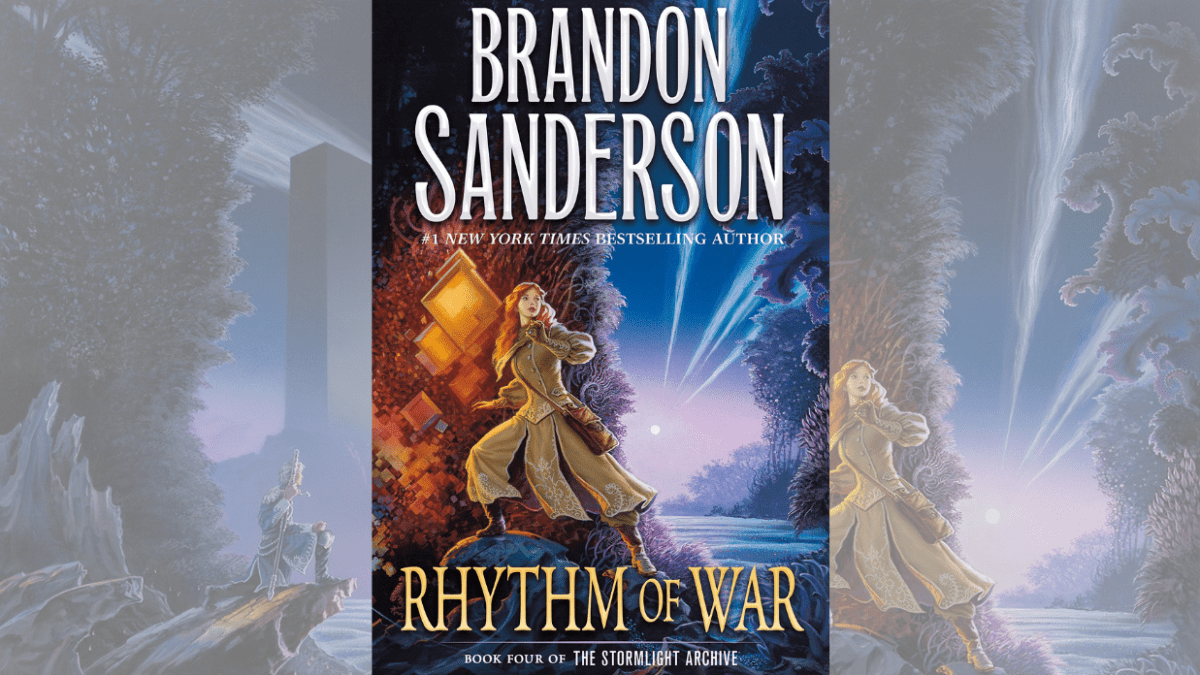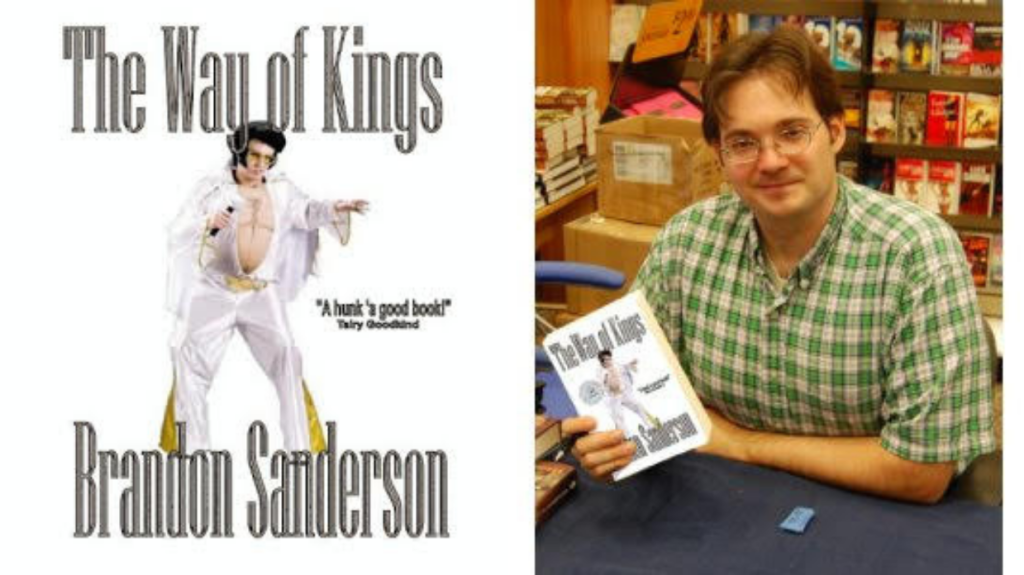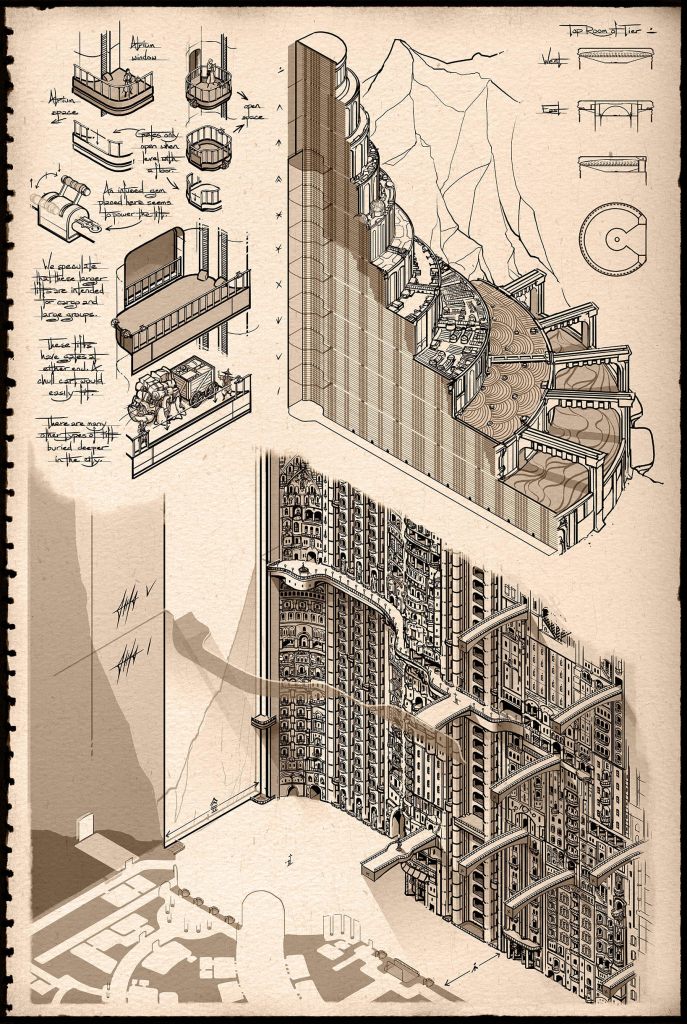Brandon Sanderson’s Rhythm of War is Built on the Shoulders of Giants
We talked to Brandon Sanderson about Rhythm of War, why adult books should get more art, and the hilarious fake cover for The Way of Kings.

This post is sponsored by 
When Brandon Sanderson wrote The Way of Kings, the first book in The Stormlight Archive series, he was ready to give up on publishing. Throwing away any ideas of what the market wanted, he decided to write something instead for himself. Now, 18 years later, Rhythm of War, the fourth book of The Stormlight Archive, marks Sanderson’s 25th novel (in addition to assorted novellas, short stories, and graphic novels), and something over seven million words of published fiction. He is, of course, not the only person who has enjoyed the epic fantasy saga.
That success was never a guarantee. Sanderson wrote 13 novels before he sold one: Elantris, in 2003. (It was published in 2005.) “The Way of Kings was number 13, the last of those unpublished books,” he recalls to Den of Geek. When trying to write for the market, he produced what he feels were some really awful novels, and beginning The Way of Kings was a way to return to the types of stories that he loved: big, chunky fantasy. “I love big epics,” he says. “I grew up on Anne McCaffrey and Robert Jordan and these really great, meaty epic fantasy series, which are my first love… I always wanted to do one of those myself.”
Rhythm of War continues the story of a war between humans and the parshmen (the singers) who are the native species of the world of Roshar. As powers of old have returned, the humans and the spren (magical spirits attuned to certain emotions or elements) have begun to reform the Radiant Knights. The singers have joined with powers to become the Fused, hosts to ancient souls in modern bodies.
The human cast includes Kaladin, a surgeon who became a soldier, benched at the beginning of the book due to his PTSD; Shallan, a woman with dissociative identity disorder who is also a master illusionist working in tandem for the heroes and a secretive spy enclave that claims to have answers to the universe; Dalinar, a Bondsmith who can heighten the abilities of others (among other gifts), and who struggles against pressures to become a high king; Navani, his wife, a queen who is more an engineer; and many others. This volume also reveals the pasts of singer sisters Eshonai and Venli as, in the present, Venli develops a secret plan for the singers’ independence, free from both human and the Fused.
The spren are one of the most fascinating fantasy inventions featured in the series, and their role is even more important in Rhythm of War as Shallan and her partner, Adolin, try to form a treaty with the honorspren to aid in the war. The spren, especially those who have bonded with humans, are reminiscent of the daemons from Philip Pullman’s His Dark Materials series, but they are also quite unique. Sanderson was partly inspired by Japanese kami, and the idea that everything has a spirit. In the world of The Stormlight Archive, the minds of people shape the energy of the world, the spirits that embody objects and emotions. By depicting the spren, Sanderson wants readers to immediately know they are in a fantastic world.
“When people have powerful emotions, they attract spren,” Sanderson explains. “They also fulfill a writerly need: a lot of times, as writers, we’re looking for [ways to] show, don’t tell.” The spren give Sanderson, he explains, a way to reveal the emotions of his characters without using cliched expressions and depictions, while at the same time heightening the sense of the world as fantastical. “It’s also just a lot of fun to write,” Sanderson adds.
Sanderson is well known for writing strong women. (In a favorite line from Rhythm of War, one character, trying to convince Kaladin to partner up, reminds him that he likes smart girls: “Is there really anyone who doesn’t like smart girls?” Kaladin immediately replies.) Sanderson’s inclusion of prominent female characters with agency as central protagonists in his work comes from the fantasy he grew up on: Anne McCaffrey, Barbara Hambly, and Melanie Rawn. The book that made him into a reader was Hambly’s Dragonsbane, which features a woman who gave up her career in magic to raise a family—a book that gave Sanderson insight into his mother’s own choices in life. When he finished, he recalls thinking: “Wait a minute, I think I just finished a fun story about slaying a dragon, and I think I understand my mom better.… That lesson stayed with me my whole life, and my whole career.”
Sanderson strives to create authentic depictions of characters outside his own experiences. “When I write characters, I try very hard to represent that character, and anything about them, as well as if that character could write, they would represent it,” Sanderson says. He hopes that when readers find a character they identify with, they read that character and think, of Sanderson: “Wow, he must be like me!” To do this, Sanderson relies on beta readers—especially in cases like Shallan’s dissociative identity disorder (DID). “DID is represented so poorly in storytelling,” Sanderson explains. “It’s really sensationalized a lot of times. I wanted to do it right.” It took many drafts and very patient beta readers to build Shallan into the fully fleshed-out character she has become.
While Rhythm of War has many moving pieces, it’s surprisingly accessible for readers who haven’t picked up previous volumes of The Stormlight Archive, while returning fans of course will feel right at home in Sanderson’s rich fantasy world. Sanderson intends all of his books to have a quality of completeness—he works to make sure that each novel has its own identity, and that the novels don’t blend in with each other. He did not design Rhythm of War with the intent that readers would pick it up first, but he’s pleased it also works that way. “I remember doing that as a kid,” he says, “not knowing the series even was a series, or not being able to find the first one, and being like, ‘Well, I’m just going to read this one.’ There’s actually a fun to that, a piecing things together.”
Readers who have been following The Stormlight Archive since The Way of Kings was released back in 2010 have been waiting eagerly (and patiently) for each volume; it’s been just over three years since the previous installment in the series, Oathbringer, was released. But, for some Sanderson fans, the wait for the series has been even longer. “Way back when I first sold Elantris,” Sanderson remembers, “my editor … said, ‘What else do you have?’” So Sanderson submitted The Way of Kings, though it was not quite ready for publishing—something the editor and Sanderson both agreed on. “Writing a 300,000-word novel is a special skill,” he explains, “and I had not practiced that specific skill yet.”
Somehow, Amazon got word that The Way of Kings existed and put up a listing for the title. As Sanderson became better known, he told fans that asked that he did plan to return to The Way of Kings, but in the meantime, fans started to post fake reviews for it, Sanderson says, complete with doctored customer photos. One fan created a book cover with an image of Elvis and a fake blurb from Terry Goodkind. Readers continued to express their eagerness with this sort of fannish love until the real version of The Way of Kings was published in 2010. (The fake listing has since been removed, after Sanderson made sure to take “copious screenshots.”)

Between the false listing and the publication, Sanderson worked on those skills to create a true epic. Part of the experience needed for such a creative feat came from taking on the final books of The Wheel of Time series after Robert Jordan’s death.
“I usually use the metaphor that I was like Sam carrying the Ring for a little bit to finish it off,” Sanderson jokes. “The Wheel of Time experience basically forced me to go to the writing books gym and lift weights much heavier than I was accustomed to.” (Sanderson’s work on completing the series led the current-in-development Wheel of Time Amazon television series team to enlist him as a consulting producer. He has read several of the scripts and given the team advice as needed. Though he is not able to reveal much about the project, Sanderson reports: “I really have enjoyed the process of working with Rafe [Judkins], the showrunner, on the television show.”)
Working on The Wheel of Time book series helped Sanderson figure out what he wanted to accomplish with The Way of Kings and the subsequent books, avoiding some of the problems he’d identified in epic fantasy. With The Stormlight Archive, Sanderson explains, “I’ve tried to make it not feel slow. I’ve tried to make it feel like each book has its own soul.”
As for the real series’ reception: “The fans just latched onto it immediately,” Sanderson says. The series itself has so many moving parts, it’s hard to make a good elevator pitch, so Sanderson claims the series’ fans had to already trust him in order to begin. He recalls the pre-internet days when readers never knew when a new book in their favorite series was coming out; now, with the immediacy and accessibility of the internet, Sanderson tries to be upfront with his readers that each Stormlight Archive book will appear about once every three years.
To “hopefully keep fans satiated between volumes,” Sanderson and his team have also included pages of original art, and beautiful front-paper and end-paper portraits in full color in the series. “Why is there not more art in books for adults?” Sanderson wonders. “Why do kids get all the art?” Including original paintings, diagrams, and illustrations reinforces Sanderson’s deep world-building. Reprints of the earlier books in the series have sometimes even had art added as readers have asked for more detail about particular aspects of the world.

The series is planned to be ten books. “I do plan it to be two five-book arcs,” Sanderson explains. “Book five should bring us to a pretty major climactic moment in the series.” In the meantime, fans of Sanderson’s world can play in it themselves via the board game, Call to Adventure: The Stormlight Archive, which features over 150 cards with art based on the world. With so much world-building already done for The Stormlight Archive, fans may wonder if a tabletop role playing game, similar to the Mistborn Adventure Game from Crafty Games, based on another of Sanderson’s series, is in the works. “No immediate plans,” Sanderson says, “but I’m sure we’ll do one eventually.”
Sanderson easily acknowledges the influences and inspirations of writers who have come before. “I have an advantage over a lot of the epic fantasy writers of my youth in that I got to read all of their books and see what was working and what wasn’t working,” he points out. But, in addition to building from other writers, Sanderson is dedicated to exploring the real world through his imaginary ones.
“Fantasy is wonderful escapism. This is why I love to read it,” he says. “But it is also a path to understanding other people. That’s what I love about fiction, and that’s what I love about fantasy in particular. It’s perhaps too lofty for me to aspire to change the world through my goofy fantasy novels, but I at least want to try to represent the world accurately so that, when you’re done with the book, if you’ve read about people different from yourself, you have come to understand them a little bit better.”
Rhythm of War is now available to buy wherever books are sold. You can find out more here.
